Did you know that insomnia is a major but poorly known symptom of Adult ADHD? One ADHD doctor said she is shocked if her patients don’t tell her about some sort of sleep problem!
A delayed circadian rhythm is the most common cause of insomnia in adults with ADHD. This can be easily treated at home with Bright Light Therapy.
Are you a ‘Night Owl’ who is exhausted every morning? Get control of your exhaustion with a simple and effective treatment!
In this post I go over the latest research and specific recommendations on using Bright Light Therapy at home for insomnia.
ADHD Insomnia and Exhaustion
Adults with ADHD have a delayed circadian rhythm due to specific anatomical and genetic differences in the ADHD brain. These differences mean that our tendency to be Night Owls has a biological cause.
The regulation of our circadian rhythm is controlled by a Master Clock in our brains which regulates our 24 hr cycle by timed release of melatonin from our brain. We usually produce the most melatonin in the early evening which makes us sleepy.
A delay in the natural melatonin production by ADHD brains means a delayed circadian rhythm. With an ADHD brain the timing of our natural melatonin release is about 90 minutes later than average!
This generally results people with ADHD having more energy at night, and not feeling tired when they want to sleep. This leads to insomnia and exhaustion in adults with ADHD.
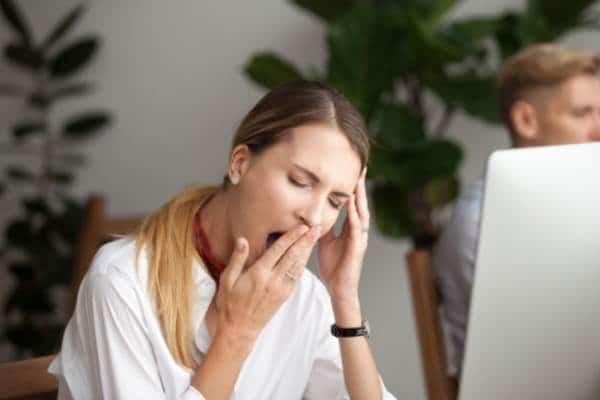
Not only that, the timing natural melatonin release also helps synchronize other functions in our body. So having a delayed circadian rhythm can have serious consequences.
The timing of melatonin production is influenced by our environment, particularly the timing of our exposure to light. This means that adjusting our exposure to light can influence our natural melatonin production, and shift our circadian rhythm.
Insomnia Light Therapy
So how can we use light to get our body producing melatonin earlier and advance our circadian rhythm (make us sleepy earlier)?
Bright Light is a very simple but powerful treatment to shift circadian timing. Light is the strongest resetting agent for our Master Clock.
Light is captured by photoreceptors at the back of our eyes and the signal is transmitted to the Central Master Clock. The timing of light exposure influences the timing of our Master Clock and our natural melatonin production.
(Another method to reset our circadian clock is to take melatonin in pill form which I discuss here.)
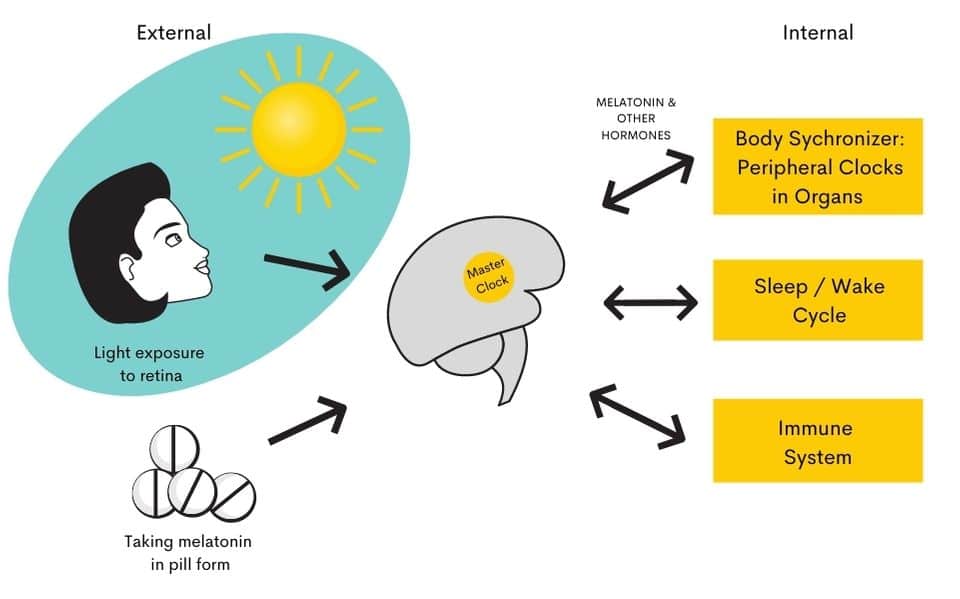
Timing of Insomnia Light Therapy
What is the most important consideration when using bright light therapy? Timing. You need to have light exposure at the right time to reset the clock.
If you so this incorrectly, you can actually shift your circadian rhythm the opposite way that you want.
Here are the 3 most important considerations for the timing of light treatment:
1. Bright Morning Light is the Most Important
Morning light means the light before waking and for a few hours after waking.
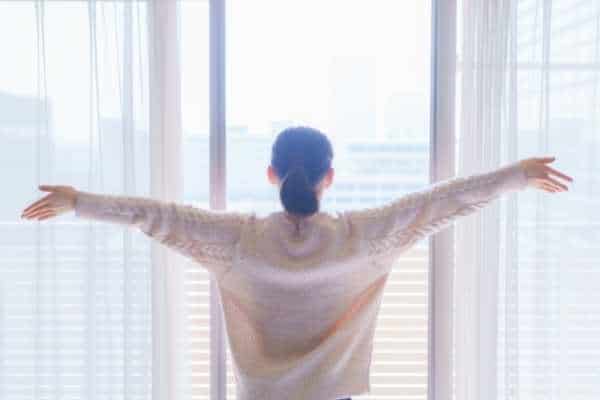
Morning light is the most beneficial for advancing your circadian rhythm. It helps correct and overcome the natural tendency to drift later in the day (keeps you from staying up late).
A study showed that Bright Light Therapy for 30 minutes a day, three hours after waking up advanced the melatonin phase and improved sleepiness and adult ADHD symptoms.
But timing is key! This is very important: Do not to add Bright Light earlier than about 1hr before your usual wake time, as light too early can lead to phase delays rather than phase advances.
Make sure you do not take a nap after a morning light treatment as this could block the effects of the light treatment.
2. Dawn: The Light Switch About 3 Hours Before Waking
So while you should not be exposed to bright light earlier than 1 hr before waking, it seems that a gradual ‘light switch’ that simulates dawn before waking can be helpful.
You could do this by making sure your curtains in your bedroom are not blocking out all of the natural dawn light. Another option is using a ‘Dawn Simulator‘.
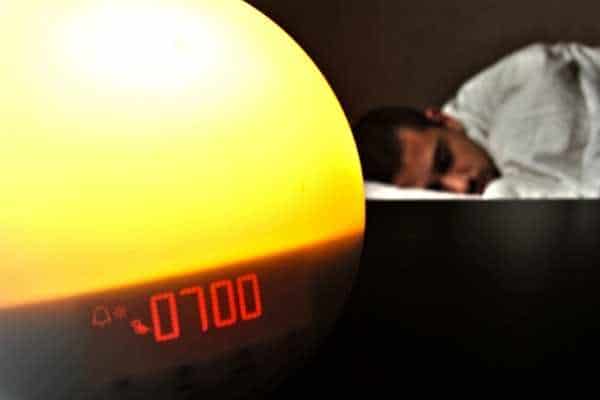
Dawn Simulators can improve cognition and overall well being. And they reduce ‘sleep inertia‘, so they might be a good option for people who really have to drag themselves out of bed.
3. Sunset: Reduce Light in the Evening Before Bedtime
Minimize as much as possible light after sunset. This light will make you drift out of sync with a 24 hour day.
One way is to reduce our exposure to light from computers and phones in the evening. It’s no joke, it has been shown that two hours of continuous use of a tablet or smartphone in the evening reduces melatonin production by 22%.
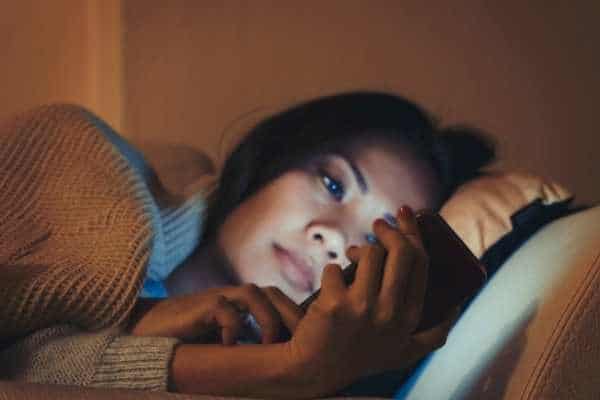
Avoiding your phone may be difficult, so using affordable blue blocking glasses can help.
A study showed that Uvex blue blocking glasses worn for 2 hours before bedtime significantly improved adult insomnia. Using blue light blocking glasses can advance the ‘time to sleep onset’ by 60-90 minutes!
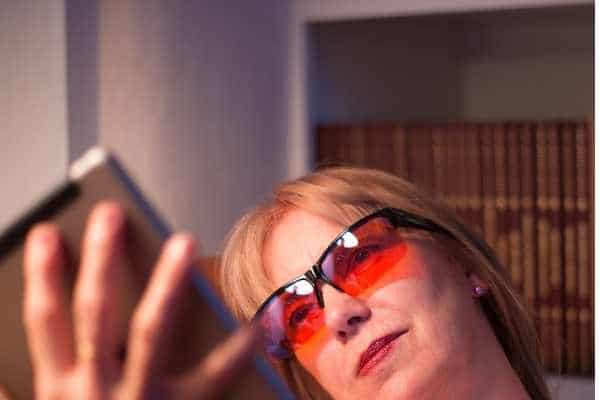
Measuring Light: What is lux?
Ok, so we’ve figured out the timing. Morning bright light exposure is the most effective way to advance our circadian rhythm with light therapy.
But how much do we need, and how do we even measure light?

Light intensity is described in units of lux. Let’s look at some real life examples of light and the lux measurement.
- Sunny day outside: about 100, 000 lux
- Rainy day outside: about 1,000 lux
- Indoor light: 100-200 lux
- Light at night in home: 40 lux or less
10,000 lux: The Right Amount?
Studies have shown that 1000 – 5000 lux is the right amount to use for bright light therapy. You can measure lux with a light meter or an app for your phone.
Lots of studies look at 1000 lux. But, sensitivity to light can be affected by environment. In these studies people were kept in a laboratory with dim light for several days. So these results might not be applicable to real world scenarios.
Most people who are exposed to some outdoor light every day may need up to 3000 lux light for the best effects.

Outdoor workers will need more lux to get the same effect from bright light therapy. This is because they have a history of bright light exposure will have reduced sensitivity.
Age can affect sensitivity as well, as the lens of the human eye yellows with age. This means older people will need more lux to change their circadian phase.
A note about the claims on packaging of bright light boxes:
Don’t always believe the claims! Light from bright light boxes might be described as emitting 10,000 lux but that intensity is measured right at the light box itself. As always, read the fine print to know what you are getting, and your light meter can help you test your bright light therapy box.
When the lux is measured about 2 feet from the light box, the lux level is usually closer to 3,000–5,000 lux. Which is still a fine amount.
Timing of Insomnia Light Therapy
The length of treatment is important, but timing of treatment is the most important.
Research shows that you still get benefit with up to 4 hrs of Bright Light Therapy, but most people aren’t able to manage such a long exposure.
1 hour, or even 30 minutes, gives good benefit and is more practical for most people.
So, we want to aim for 3000-5000 lux of light for 30-60 minutes, within 3 hours of waking.
DIY Insomnia Light Therapy: Outdoor Light
Outdoor light is the easiest and cheapest option. Adjust your schedule to get outdoor light in the morning. Walk your dog, go for a walk, do some errands! Take your morning coffee outside!

Soak up those rays! Without sunglasses! Don’t forget, you are trying to expose your retina to bright light.
Remember, a sunny day is about 100, 000 lux and a rainy day is about 1000 lux. So even a rainy day can provide a decent amount of lux.
Obviously there will be times where outdoor light will not work, and that’s when you think about getting a Bright Light Box.
Best Light Box for Insomnia
When it comes to Bright Light boxes there are many options. So what’s the best light box?
Research shows that larger white broad spectrum light boxes might be best in terms of easier exposure. If you have the space at home in a place you can always use then go for a large light box.
In the study, they liked this Philips EnergyLight as you can tip it towards your face, for the best light exposure. Many people will set up their light boxes in a specific room, and read a book or use an iPad on the table while using it.
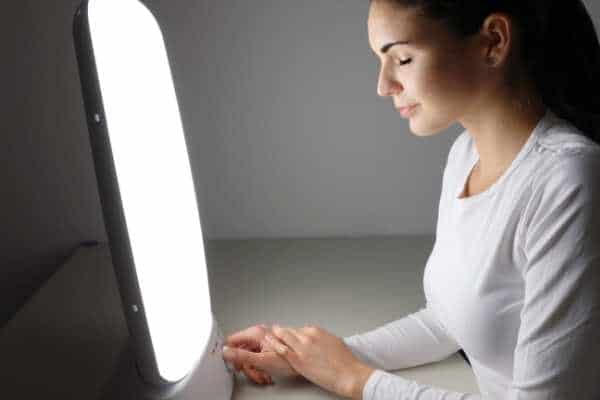
One trick they suggested is to attach a piece of string to the light box which is the distance you should sit from the light box (about 2 feet). As you sit down you can use the string to confirm you are sitting the proper distance.
Another option to make sure you are really getting a good dose of morning Bright Light treatment is to get two light boxes. Set the 2 Light Boxes up to your right and left and then you can work on a computer screen in between the light boxes, without blocking the light.
Sometimes, having a really large light box might not always work. Smaller battery powered light boxes might be better if you need to travel.
The issue with a smaller light box is that it is harder to make sure you are getting the light on your face. You may need to use a mirror to make sure that your face is properly lit by the light box.
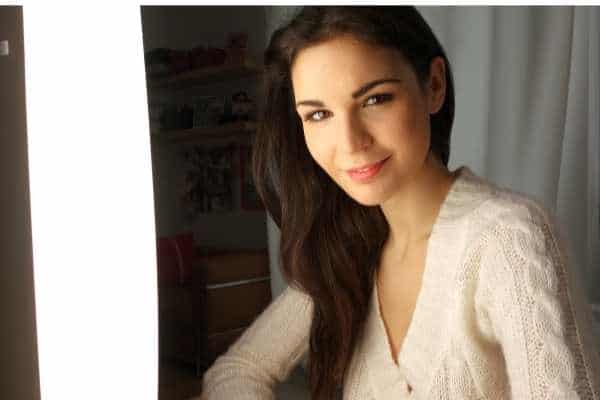
Blue Light Therapy: A Better Choice?
If you are sensitive to bright light, then Blue light therapy is a better choice for you.
Blue light was not more effective than broad spectrum while light boxes when studied. But some people just couldn’t manage being exposed to the bright white light.
If bright light bothers you, and you need to dim the light to manage the treatment, then blue light is a better choice.
Blue light does work better at a dimmer light intensity. This is due to different receptors in the retina absorbing light in dimmer light conditions.
This is a very popular option of a portable blue light, highly recommended by Tim Ferris, of The 4-Hour Workweek.
Light Visors or Light Glasses
Sitting in front of a light box for 30-60 minutes? Sometimes that is easier said than done, only about half the people in the studies could do it on a regular basis.
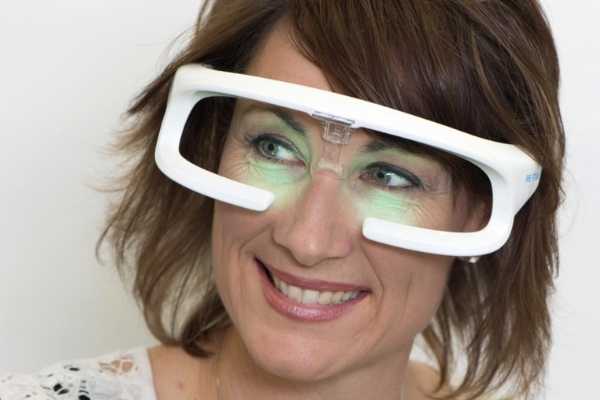
Another option is something you can wear. Re-Timer glasses may look ridiculous, but they seem to work. They certainly make it easier to get your daily dose of Bright Light without having to sit down in one spot for an hour.
Side Effects of Insomnia Light Therapy
Bright Light Therapy sounds pretty safe, but are there any side effects or other concerns? Not too many fortunately.
Apparently patients rarely stop treatment due to side effects, more often people stop because of the time involved and the inability to make the treatment a habit.
Some side effects of bright light therapy include headache, eyestrain, nausea and agitation but usually they go away after a few sessions.
You might be concerned about the effects to your eyes of exposing yourself to bright light daily, but in people who used bright light daily for 6 years there were no changes on ophthalmologic examination.
One rare but serious side effect of bright light therapy is mania in bipolar patients who overexpose themselves to the light.
There are some contraindications to brightlight therapy. Avoid this treatement is you have existing eye disease, migraine headaches (if elicited by light), phototoxic medication use, or a history of mania.
Summary: Bright Light Therapy for ADHD Insomnia
A major issue for ADHD insomnia is a delayed circadian rhythm. Bright Light Therapy can be an effective and simple treatment for advancing the circadian rhythm and natural melatonin timing.
Bright light therapy can improve insomnia, cognition and mood. And since melatonin timing is responsible for regulating organs in the body, it may have other beneficial effects.

The basic Insomnia Bright Light formula is this: 3000-5000 lux, for 30-60 minutes, within 3 hours of waking up.
You can also try optimizing with a Dawn Simulator for waking and Blue light blocking glasses in the evening.
Beyond Bright Light Therapy for ADHD Insomnia
Melatonin supplementation can be added to Bright Light Therapy. Taking melatonin in pill form (also called exogenous melatonin, or melatonin supplementation) before bedtime, can further help to advance the circadian rhythm.
However Dr. Huberman of the Huberman Lab does not recommend melatonin, and instead suggests a ‘sleep cocktail’ of magnesium threonate, apigenin and L-theanine.
Another thing to realize is that insomnia and ADHD are biologically linked. Every sleep disorder is more common in people with ADHD. ADHD insomnia is not just due to poor ‘sleep hygiene’ because a person with ADHD ‘can’t control themselves’.
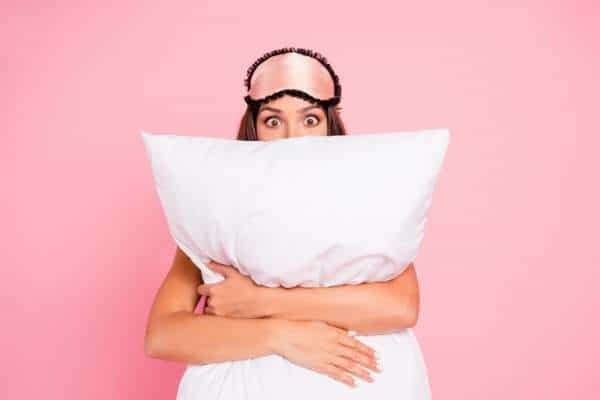
The biological link between ADHD and insomnia is not widely known, but research is now proving it. Overall, ADHD is really poorly understood and quite frankly very stigmatized.
While the most common issue with ADHD insomnia is a delayed circadian rhythm, there are tons of other reasons to have insomnia with adult ADHD.
Needing something more than light therapy and melatonin for adult ADHD insomnia is not a personal failure. Sleep is incredibly important.
Don’t be ashamed of insomnia you cannot manage, go speak to your physician about other options.
References
- Effect of Light and Melatonin and other Melatonin Receptor Agonists on Human Circadian Physiology
- Correcting Delayed Circadian Phase with Bright Light Therapy Predicts Improvement in ADHD Symptoms: A Pilot Study
- Effects of artificial dawn and morning blue light on daytime cognitive performance, well-being, cortisol and melatonin levels
- Dawn simulation light impacts on different cognitive domains under sleep restriction
- The human circadian pacemaker can see by the dawn’s early light
- Blocking nocturnal blue light for insomnia: A randomized controlled trial
- Wearing blue light-blocking glasses in the evening advances circadian rhythms in the patients with delayed sleep phase disorder: An open-label trial
